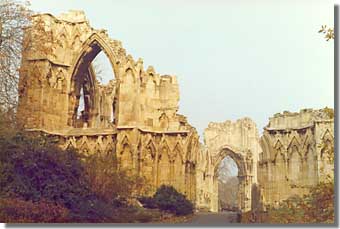

Encyclopedia | Library | Reference | Teaching | General | Links | About ORB | HOME
 St. Mary's Abbey, a Benedictine community, was built as
the result of patronage by the king
in 1088, on the site of an older religious foundation. It lay just
outside the city wall, which provided its eastern boundary, in its
own walled precinct. This proximity to the city and the fact
that the abbey liberty was outside city administration almost
inevitably meant that there would be conflicts
between abbey and city officials over territorial (e.g. rights
on common land outside the walls, right-of-way through the liberty
along the wall) or jurisdictional (e.g. freedom from tolls and murage,
rights to hold inquests within the liberty), and personal disputes
between abbey tenants and citizens. In the mid-1440s the city was
suing the abbey in regard to fishgarths placed in the section of the
Ouse adjacent to abbey-owned land; these obstructed river navigation
and therefore affected water-based commerce. The city paid out
over £250 in legal costs in this dispute, necessitating special taxes
upon the citizens to cover the expense.
Cathedrals, monasteries and abbeys – initially Benedictine, but joined in
the twelfth century by Augustinian houses – were a part of the
ecclesiastical element in many of the larger towns. Although, unlike
parish churches and the
orders of friars, they were not as popular
with townsmen, in part because they were rivals for commerce and authority,
and in part because monks were considered too worldly – in contrast to the
more austere friars who won the townspeople's respect. On the other side
of the fence, monastic communities found that the worldly temptations
presented by urban society made it difficult for them to exist in that
environment.
The ruinous remains of St. Mary's Abbey date mostly from the thirteenth
century. Today they provide a backdrop for the medieval mystery plays
associated with York (which originally were staged at various points in the
city streets).
St. Mary's Abbey, a Benedictine community, was built as
the result of patronage by the king
in 1088, on the site of an older religious foundation. It lay just
outside the city wall, which provided its eastern boundary, in its
own walled precinct. This proximity to the city and the fact
that the abbey liberty was outside city administration almost
inevitably meant that there would be conflicts
between abbey and city officials over territorial (e.g. rights
on common land outside the walls, right-of-way through the liberty
along the wall) or jurisdictional (e.g. freedom from tolls and murage,
rights to hold inquests within the liberty), and personal disputes
between abbey tenants and citizens. In the mid-1440s the city was
suing the abbey in regard to fishgarths placed in the section of the
Ouse adjacent to abbey-owned land; these obstructed river navigation
and therefore affected water-based commerce. The city paid out
over £250 in legal costs in this dispute, necessitating special taxes
upon the citizens to cover the expense.
Cathedrals, monasteries and abbeys – initially Benedictine, but joined in
the twelfth century by Augustinian houses – were a part of the
ecclesiastical element in many of the larger towns. Although, unlike
parish churches and the
orders of friars, they were not as popular
with townsmen, in part because they were rivals for commerce and authority,
and in part because monks were considered too worldly – in contrast to the
more austere friars who won the townspeople's respect. On the other side
of the fence, monastic communities found that the worldly temptations
presented by urban society made it difficult for them to exist in that
environment.
The ruinous remains of St. Mary's Abbey date mostly from the thirteenth
century. Today they provide a backdrop for the medieval mystery plays
associated with York (which originally were staged at various points in the
city streets).
|
Encyclopedia | Library | Reference | Teaching | General | Links | Search | About ORB | HOME The contents of ORB are copyright © 2003 Kathryn M. Talarico except as otherwise indicated herein. |